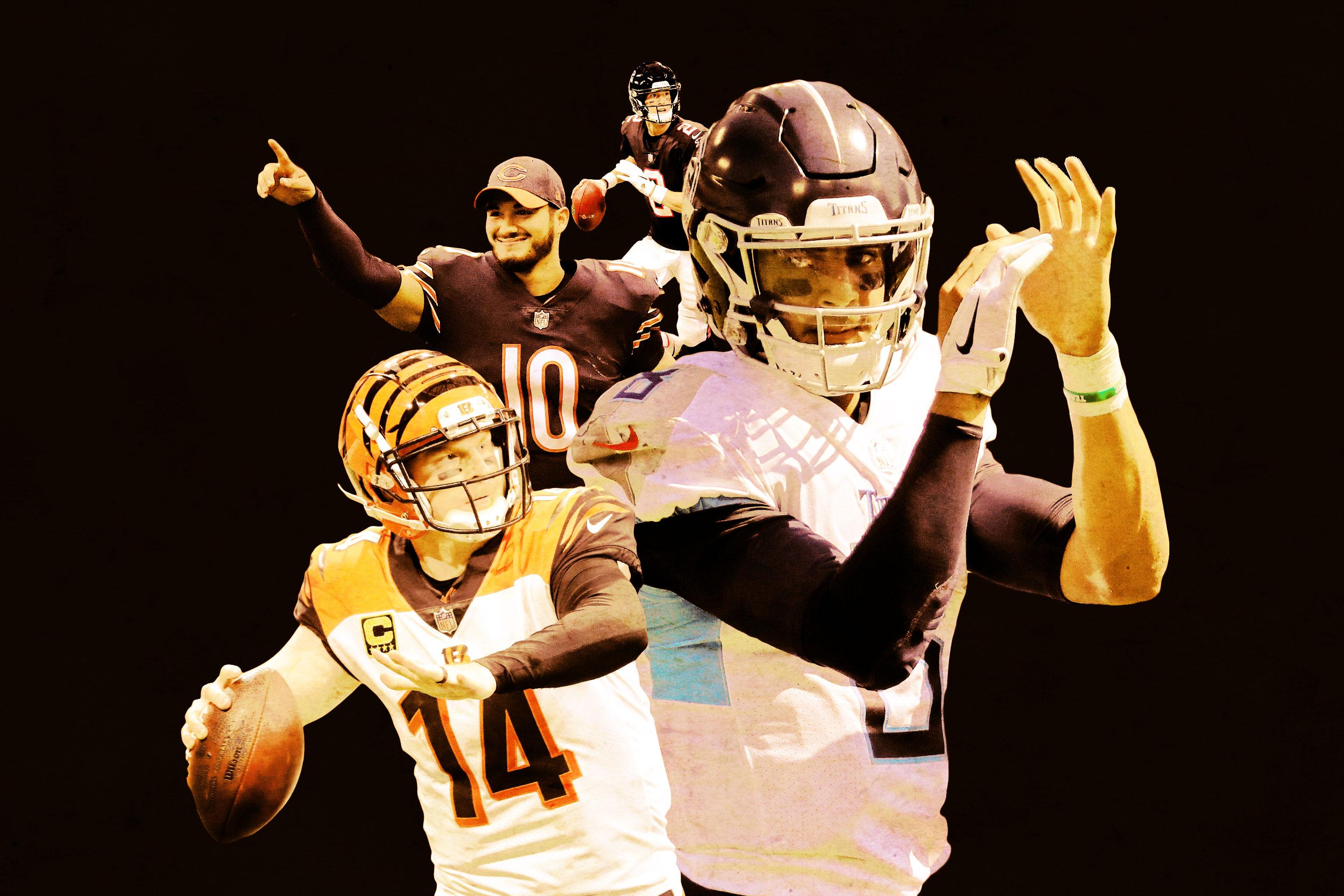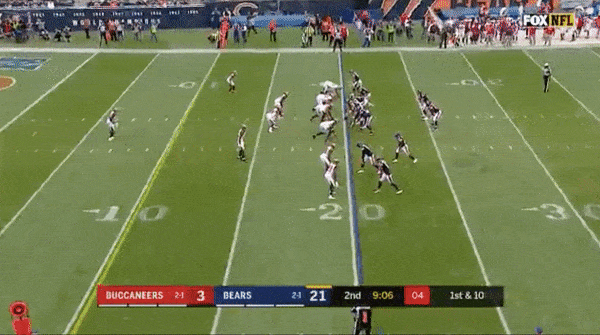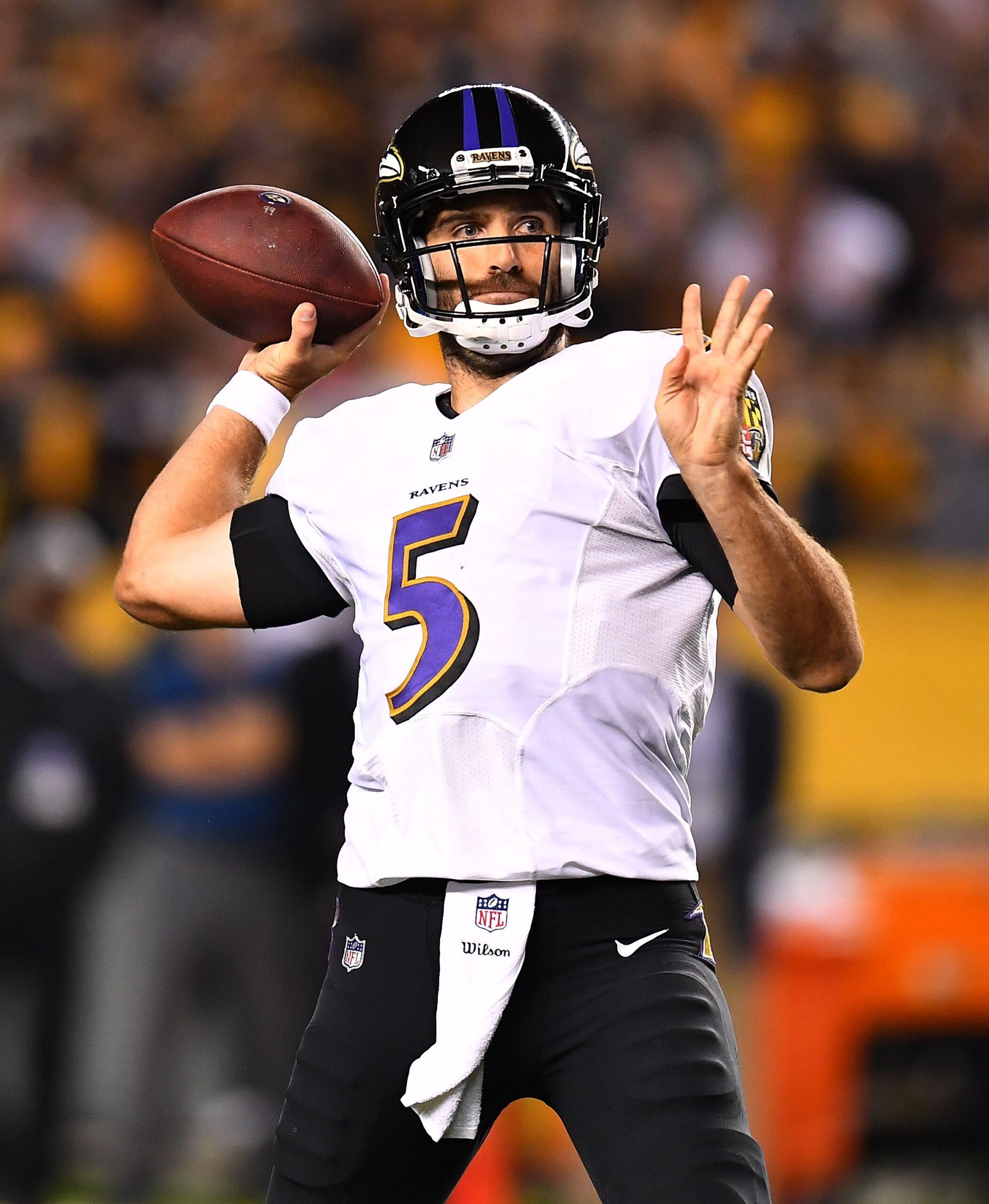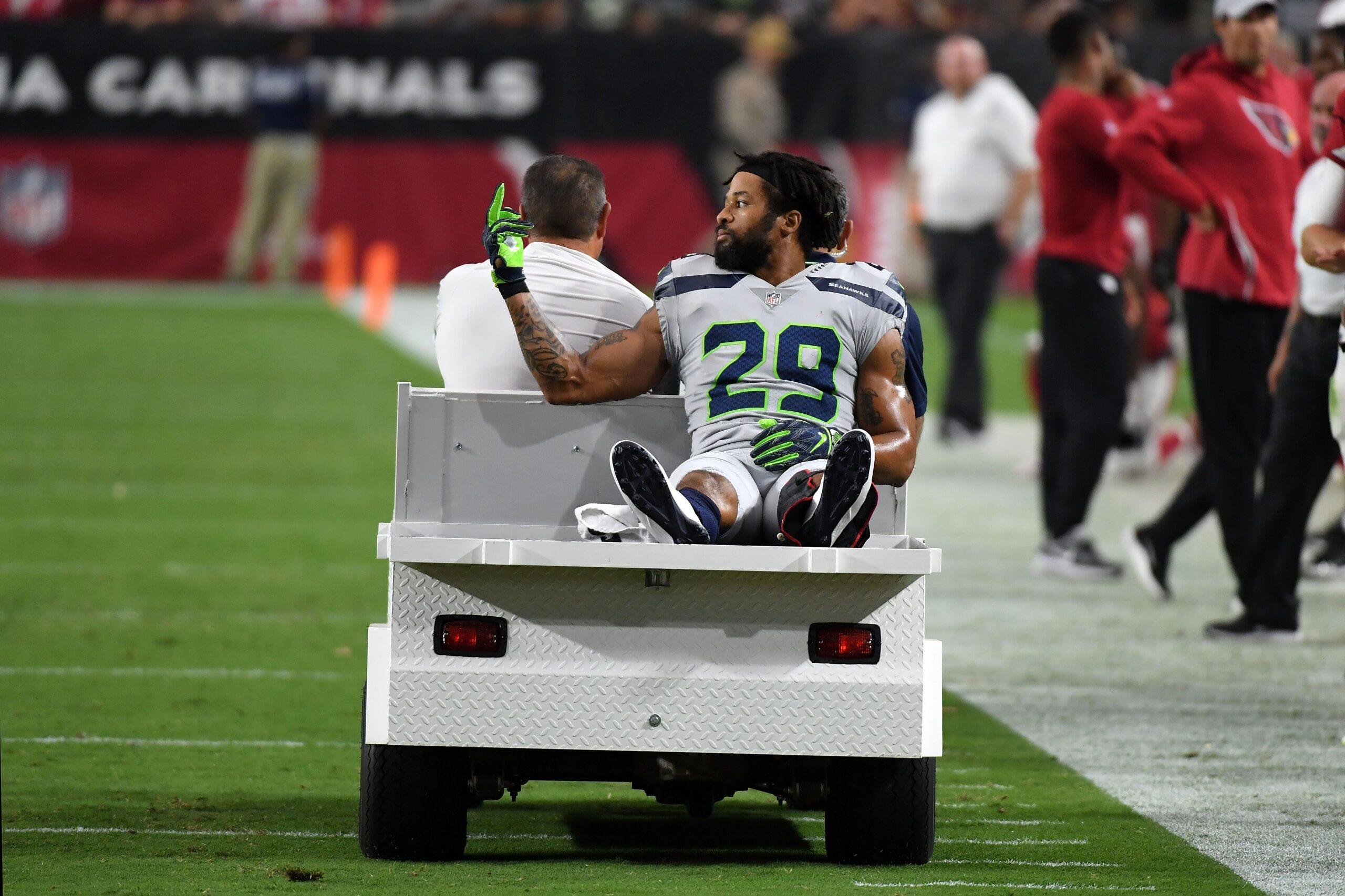The Starting 11: What Did Week 4 Reveal About the NFL’s Playoff Picture?
After impressive performances from Marcus Mariota and the Titans, Mitchell Trubisky, and the Bengals offense, a few teams have already inserted themselves into the postseason conversation. But will that emerging landscape last?
Welcome to the Starting 11. This NFL season, we’ll be collecting the biggest story lines, highlighting the standout players, and featuring the most jaw-dropping feats of the week. Let’s dive in.
At the quarter mark of the NFL season, it’s still too early to draw firm conclusions about most teams. But, as both hot and terrible starts can be enough to help determine a team’s postseason fate, four games in is the perfect time to begin charting the playoff landscape. So for this week’s Starting 11, let’s take a look at Sunday’s most important developments as they pertain to the emerging playoff picture.
1. The Titans hung around just long enough to win a 26-23 overtime game against the Eagles on Sunday, and now rookie head coach Mike Vrabel’s team is in prime position for a return trip to the postseason. As Vrabel said following the Titans’ Week 2 win over the Texans, this team hasn’t been winning any beauty contests. Tennessee’s 2-1 start included rock fights against Miami and Houston and an unwatchable 9-6 win over the Jags in Week 3. It was painfully obvious just how much the Titans offense was missing a healthy Marcus Mariota—who’s been dealing with an elbow injury—and he showed up in Sunday’s win.
In last week’s win over Jacksonville, Mariota could barely grip the ball. The nerve damage resulting from a hit he took in Week 1 led to a parade of lame-duck passes and knuckleball throws, and Tennessee was unable to sustain any consistent offensive production. Against the Eagles, Mariota looked the best he has since 2016. He was on target all game, and at every level of the field: He threw perfect deep shots to Corey Davis and Taywan Taylor, and only the tip of cornerback Ronald Darby’s finger stood between Mariota and another bomb to wide receiver Darius Jennings.
That performance was made possible in part by first-year offensive coordinator Matt LaFleur, whom Vrabel brought in this offseason. The way that the previous coaching staff in Tennessee used Mariota’s talents was often infuriating. His 122.8 passer rating with play-action last season was the highest in the league among qualified quarterbacks, yet he used play-action on just 23.5 percent of snaps, which ranked 14th in the NFL. Sunday, LaFleur dialed up a healthy diet of play-action throws (28.6 percent of dropbacks), and a vast majority of the team’s big gains came on those downs (Mariota was 11-of-14 for 146 yards with two touchdowns and a 118.8 passer rating using play action). LaFleur, who’s been on several staffs that use play-action as an offensive pillar, is willing to play to his young quarterback’s strengths.
Over the past couple of offseasons, general manager Jon Robinson has done an excellent job surrounding Mariota with a variety of pass catchers who complement each other well. Taylor is rounding into a dynamic downfield threat now that his playing time has increased, and Davis was a serious problem for the Eagles’ secondary this week as he hauled in nine passes for 161 yards and the game-winning score. With Dion Lewis attacking teams as a receiver out of the backfield, the Titans have enough options for Mariota to thrive in this offense.
The most important factor, though, is that Tennessee was able to hang around long enough against the Eagles to give Mariota that chance. By eking out some early wins with Mariota either on the shelf or playing hurt, the Titans bought enough time for him to get healthy and settle into a drastically better scheme than the one he played in under Mike Mularkey. As long as Mariota is healthy enough to play the way he did Sunday, this group should only get better as the season goes along. Paired with a defense that features an exciting group of pass rushers up front, a talented group of cornerbacks, and a coordinator with a knack for dialing up the right pressures at the right time, the Titans could emerge as serious contenders in a diluted AFC.
2. Mitchell Trubisky’s shocking six-touchdown performance against the Bucs showed just how dangerous the Bears can be. I wanted all 11 of these items to be different Trubisky moments from Sunday’s 48-10 win over Tampa Bay, but here at The Ringer, we have these things called “editors.” That game was a surreal experience for Bears fans. After three frustrating weeks from Chicago’s second-year quarterback, head coach Matt Nagy’s offense looked virtually unstoppable.
Trubisky was launching balls to every level of the field, and, thanks to a virtual play-calling clinic from Nagy, several of those missiles found wide-open receivers. Chicago’s fourth touchdown of the day came on a play when the Bears lined up in a 3x1 receiver set with trips to the left. So far this season out of that formation, Nagy has favored an RPO concept that involves a bubble screen to running back Tarik Cohen out of the slot. This time, instead of predictably going to Cohen or handing off to Jordan Howard, wide receiver Josh Bellamy faked a quick block, sprinted down the sideline, and—after a quick shoulder fake to influence the cornerback—Trubisky turned his eyes downfield and hit Bellamy in stride for the score.

Nagy schemed Chicago to big plays against the Bucs, but Trubisky also showed massive improvement over the first three weeks. His touchdown pass to wide receiver Allen Robinson on a slot fade late in the first quarter was perfectly placed to the left corner of the end zone, and the 33-yard chunk gain to Taylor Gabriel early in the second quarter came on a route almost identical to one Trubisky had overthrown twice already this season.
While some of Trubisky’s throws were undeniably impressive, even more encouraging was his demeanor as a passer. His main problem through the Bears’ first three games (aside from a few accuracy issues) was that he looked unsettled in the pocket. Even as receivers ran open down the field, Trubisky’s reluctance doomed Nagy’s designs. But against Tampa Bay, he was assertive. He did an expert job settling his feet before delivering a 35-yard strike on a hole shot to Cohen down the left sideline to set up Chicago’s third touchdown. And on a play-action throw with about 10 minutes remaining in the second quarter, Trubisky calmly drifted outside the pocket—with his eyes downfield—to reset the launch point for a deep shot to tight end Trey Burton.
A game like Sunday’s could go a long way in instilling the confidence Trubisky lacked early in the season. If Chicago can get more consistent play out of its quarterback, this team has the system and the playmakers to become a quality NFL offense. Pair that with the league’s best defense to this point in the season, in an NFC North that looks increasingly open as the Packers and Vikings struggle to get their footing, and Chicago’s playoff chances have become a reality.
3. The Steelers continue to stew in their own drama. Every year, it seems like Pittsburgh is good for one “the sky is falling” game. Last season, it was the team’s embarrassing Week 5 loss to Jacksonville that prompted Ben Roethlisberger to wonder aloud whether he “had it any more.” The 2018 version came Sunday night, when a dud of a second-half performance led to a 26-14 loss to the hated Ravens. The Steelers offense looked out of sorts against Baltimore over the game’s final 30 minutes, as Roethlisberger missed some throws, forced others, and the Pittsburgh ground game went nowhere; running back James Conner managed only 19 yards on nine carries. It’s officially time to admit that this offense misses Le’Veon Bell.
And the defense is faring even worse. After being lit up by Ryan Fitzpatrick and the Buccaneers in Week 3, Pittsburgh’s secondary couldn’t keep up with Joe Flacco and Baltimore’s receivers Sunday night. That may sound like a sentence out of a bad dream, but the Ravens’ passing game has been shockingly effective so far this season. Flacco has completed 64.3 percent of passes while averaging 7.3 yards per attempt, and the Ravens ranked 11th in passing DVOA entering Week 4. They should only move up those rankings this week, after Flacco threw for 363 yards and a pair of scores.

4. The Ravens, meanwhile, are sitting at 3-1 and seem to have unlocked the best version of their offense. Offensive coordinator Marty Mornhinweg had a well-orchestrated game plan against the Steelers that fit his quarterback’s best traits. The Ravens used play action on nearly a quarter of their dropbacks (22.7 percent) and coupled that action with seven-man protection schemes that gave Flacco ample time to let his receivers work free down the field (Flacco averaged a staggering 13.0 yards per attempt on his play-action throws). Pittsburgh was ill-equipped to deal with speedster receiver John Brown, whose style seamlessly meshes with Flacco’s strengths as a deep-ball thrower. If the Ravens’ offensive line can consistently give Flacco time to find Brown, Michael Crabtree, and his collection of tight ends, Baltimore has more than enough talent on defense to be a troublesome playoff team.
5. One hurdle in the Ravens’ way may be the Bengals, who are also 3-1 after pulling out a thrilling 37-36 win over the Falcons on Sunday. Cincinnati has been trying to replicate its high-powered 2015 offense for years, but the biggest obstacle has been the play of its offensive line. With the departure of stalwarts Andrew Whitworth and Kevin Zeitler in free agency and the front office’s missteps early in the draft—where they selected tackles Jake Fisher and Cedric Ogbuehi—Andy Dalton had been under siege for most of the past two seasons. Some protection issues in Sunday’s second half did prevent the Bengals from hanging 50 points on a decimated Falcons defense, but for the most part, Cincinnati’s offensive line has been playing well enough for Dalton and his pass catchers to function. That’s encouraging, because with A.J. Green, the emergent Tyler Boyd, and shifty back Gio Bernard sharing the field, the Bengals have more than enough receiving talent to cause headaches for defenses. Losing tight end Tyler Eifert, who has a broken ankle, is a significant blow for this unit (more on that later), but the way that Dalton and this group are playing right now, the Bengals can push Baltimore and the rest of the wild-card hopefuls in the AFC.
6. As for those Falcons, their plan to “give up 35 points but score 40” may not be a practical route to the playoffs. Atlanta’s offense is rolling right now. A week after tossing five touchdown passes in a loss to the Saints, quarterback Matt Ryan threw for 419 yards and three scores against a Bengals defense that theoretically has some good players. Since Week 1, offensive coordinator Steve Sarkisian has done an excellent job of scheming ways to get his various playmakers the ball. Julio Jones is still a centaur that happens to play football, but Atlanta’s offense has blossomed because players like rookie receiver Calvin Ridley are finding ways to play off Jones and take advantage of single coverage. Ridley hauled in two more touchdown receptions Sunday (his fifth and sixth of the season), with one coming on a double move in the red zone. Ryan and Co. are moving down the field as they please, and if this version of the offense had been in place last season, Atlanta could have easily won the Super Bowl. But a defense missing Deion Jones, Keanu Neal, and Ricardo Allen just isn’t equipped to stop offenses in 2018.
7. On the flip side, the Saints have controlled the division, despite their defensive struggles. The talent of New Orleans’s offense takes over games, even on days when they’re not firing on all cylinders. Drew Brees and the passing game had an uncharacteristic off day against the lowly Giants on Sunday (just 217 yards passing on 32 attempts), but there’s no reason to worry. Alvin Kamara still exists. Kamara finished the Saints’ 33-18 win with 181 yards from scrimmage and three more touchdowns on the ground, including a back-breaking 49-yard scamper to seal the game. After earning the crown as the NFL’s most exciting player during his rookie year, it may seem as though Kamara hasn’t been quite as dominant in his second season. Well, he’s on pace for an absolutely absurd 2,444 yards from scrimmage and 24 total touchdowns. That’s the point we’ve reached with Kamara and the Saints; his standard is production that would likely make him the Offensive Player of the Year. Even if Brees, Michael Thomas, and the New Orleans passing game go dormant for a week, this team can still coast to 26 points. Defensive regression came hard for the Saints this year, but behind this offense, New Orleans is still the most complete team in the NFC South.
8. The Dolphins were the NFL’s surprise undefeated team through three weeks, but after a lopsided loss to the Patriots on Sunday, it’s time to reassess their playoff aspirations. It took one game against New England to show that Miami’s reputation as a sound, capable defense was an illusion. The Dolphins looked inept as they tried to deal with the Patriots’ pass catchers and backs in space. Rookie running back Sony Michel cruised to 112 rushing yards on 25 carries after struggling to do much on the ground against the Lions in Week 3. Fellow back James White toyed with the Dolphins linebackers on routes all over the field, including a touchdown reception down the left sideline. And Miami’s offense took an unfortunate page from the defense’s playbook by falling apart as well. The explosive, creative unit that had been on display for the first three weeks was nowhere to be found as Ryan Tannehill mustered just 100 yards on 20 attempts. That’s hard to do in this day and age. The Dolphins probably fall somewhere between the group we saw over the first three weeks and the team on display against the Patriots, but there’s no doubt that New England exposed them.
9. Tyler Eifert’s brutal ankle injury was a crushing moment for a player enjoying a resurgence. Eifert has had a tragic injury history in his six-year NFL career. The former first-round pick was on his way to becoming a superstar in 2015 when he caught 13 touchdown passes for the high-flying Bengals offense. His body has betrayed him ever since. A litany of different ailments caused Eifert to miss 22 of Cincinnati’s 36 games over the past two seasons. This year he came into the offseason fully healthy, signed a one-year, $5.5 million deal designed to rebuild his value, and looked well on his way to achieving that end. Sunday, Eifert caught three passes for 36 yards and a touchdown in the first half and proved himself to be a key cog in the Bengals’ passing game.
Early in the third quarter, though, disaster struck again. While fighting for extra yards on a short completion, Eifert’s ankle snapped. The replay itself was gruesome, but Eifert’s reaction was even harder to watch. Tears streamed down his face as he was carted off the field. At 28 years old, Eifert has already endured more injuries than most NFL players could imagine facing in an entire career. He’s scraped and fought his way back over and over, refusing to bend to the limitations of his body. And now, he’s done for the season—again—without a contract for next year. Injuries are so commonplace in the NFL that it’s easy to forget players who get hurt. Carson Wentz, Jason Peters, and Darren Sproles will go down as footnotes in Eagles’ Super Bowl lore. But to watch Eifert on Sunday is to see a glimpse of how hard it is for a player when his livelihood and dreams are torn away. Eifert will likely rehab over the next five months and be ready for free agency again in 2019. But the road back gets harder every time.
10. On the topic of devastating player injuries, let’s chat briefly about the Earl Thomas situation in Seattle. When Thomas ended his contract holdout just before the season began, the image of him being carted off the field with an injury was undoubtedly one of his greatest fears. That fear became a reality on Sunday as Thomas, who’s been playing on the fourth and final year of the contract he signed in 2014, suffered what looked like a season-ending broken leg against the Cardinals.
Thomas held out over the summer because he felt he deserved a long-term commitment from the franchise, and it’s hard to blame him. As the rest of the players who made up the Legion of Boom were released or decided to retire, Thomas was the lone remaining member of Seattle’s defining unit. Earl Thomas was the Seattle Seahawks defense during an era when that group ruled the NFL. If the Seahawks had no intention of giving their franchise defensive player long-term security moving forward (a fair decision, considering he’s about to turn 30), they should have traded him to a franchise that would have given him the extension he desired. Smart NFL teams should hunt for value at every turn, and the Seahawks are known for doing just that.

But if the Seahawks did, in fact, turn down a second-round pick for Thomas—a return Dallas was rumored to have offered them—I’m not sure prudency and value are at issue here. The 2018 Seahawks are not a playoff team, let alone a contender. Their relationship with Thomas has soured to the point that he gave the fucking middle finger to Seattle’s sideline as he was carted off the field in Arizona. He was on his way out no matter what following the season (unless the Seahawks were to franchise tag him, in which case, just sign him), and the best-case scenario for the Seahawks there would be recouping a compensatory third-round pick when Thomas signed a big-money deal elsewhere. Now, coming off a season-ending injury, it’s more likely that Thomas signs a one-year deal with another team, and the Seahawks gets nothing. As they should. It’s not hard to do right by a player who made your franchise what it is; until players are no longer cut with years remaining on their contracts, the idea of “honoring a contract” is a nonstarter in the NFL.
11. This week in NFL players, they’re absolutely nothing like us: Saquon Barkley is incredibly good, even if the Giants are not.
It’s a shame Barkley was drafted to this garbage team second overall. He’s often the best athlete on the field—none of this is his fault.